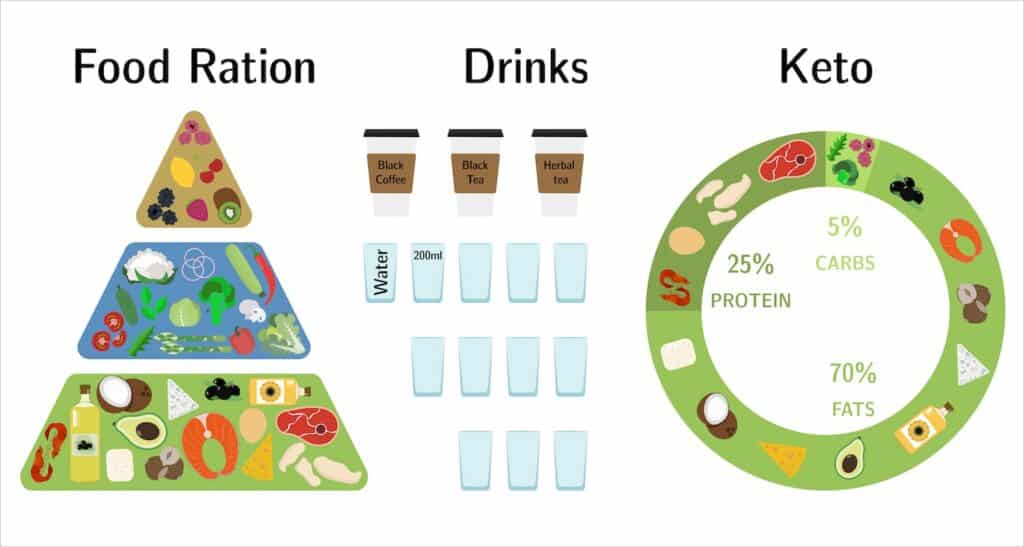You may be curious about what a fasting imitation diet is. This is a unique approach to diet that combines elements of fasting with a specific diet plan.
This combination has been shown to have several potential health benefits, and we’ll explore these in this article. Let’s dive into the world of fasting imitation diets together.
How can you eat and fast at the same time?
It may seem like a contradiction to eat and fast at the same time. But that’s exactly what you do in a fasting imitation diet. But how does it actually work?
The fasting diet is about more than just when you eat. It also focuses on what you eat. This is what sets it apart from, for example, intermittent fast ing. While intermittent fasting is about eating and fasting for specific windows of time, the fasting imitation diet is about eating meals that are carefully composed to mimic a fasting state in the body.

In a fasting imitation diet, a typical day may involve a light meal with high protein, moderate fat and low carbohydrate content to maintain a fasting-like state in the body.
This can be followed up with periods of fasting. With this method, you can experience the benefits of fasting while still getting essential nutrients from food.
This is the fasting imitation diet
The fasting diet is a unique way of approaching food intake and health. Unlike traditional diet planning, this diet is designed to mimic the effects of fasting, while still providing essential nutrients.
On a fasting imitation diet, you will eat meals that are specifically designed to maintain a fasting-like state in the body. This is achieved by having a carefully planned composition of nutrients in each meal.
The meals will be high in protein, contain moderate amounts of fat, and be low in carbohydrates. The goal is to maintain a metabolic state similar to fasting, even though you are eating.
This differs from other diets such as fasting diets, where the focus is only on when you eat, not what you eat. With a fasting diet, you only have certain periods of time where you eat and other periods where you fast, with no specific requirements for what you eat during the eating periods.
Fasting diets, on the other hand, emphasize both when you eat and what you eat, to maximize the potential health benefits.
What can you eat on a fasting diet?
The fasting imitation diet is about eating the right type of food to maintain a fasting-like state. Here are some foods you can include in your diet:
- Protein sources: Chicken, fish, eggs and meat.
- Fats: Olive oil, avocado, nuts, butter.
- Carbohydrates: Vegetables, and berries in moderation.

The key is to focus on whole, unprocessed foods and avoid sugary and processed foods. Remember to drink plenty of water and avoid sugary drinks.
Related article: Eating zero carbs with the carnivore diet?
Can autophagy really make the body clean up its own cells?
Autophagy is a process where the body breaks down and recycles its own cells. It is an important process for cell health and function, and it is one of the biological mechanisms activated by fasting.
During a fasting imitation diet, the idea is that you can stimulate this autophagy process through your diet. By eating foods that help the body enter a fasting-like state, you can potentially stimulate autophagy and gain the associated health benefits.
Scientific research supports the idea that fasting can activate autophagy. Research has shown that autophagy can help protect against diseases such as cancer and heart disease, as well as play a role in the aging process.
Advantages of fixed
There has been a lot of research into the potential health benefits of fasting and fasting-imitation diets. Here are some of the key benefits observed:

The fasting mimicking diet aims to reap these benefits through a diet that mimics the effects of fasting, while still providing essential nutrients.
Related diet: The keto diet is perfect for fasting diet?
Intermittent fasting can slow down the aging of the body
Research has begun to point towards the idea that intermittent fasting can have an anti-ageing effect and improve health. This is thought to be due to a process called autophagy, where the body removes and recycles damaged cells, which can help delay the aging process.
Some animal studies have shown that intermittent fasting can extend lifespan. Human studies are in their early stages, but some studies have shown improved biomarkers related to aging, such as reduced levels of insulin, improved cholesterol profile and reduced inflammation.
Is eating fasting the same as intermittent fasting?
Eating fasting and temporary fasting (also known as intermittent fasting) are two different diet concepts, although they both involve periods of fasting.
Intermittent fasting refers to a diet method where you cycle between periods of eating and fasting. There are several different methods of intermittent fasting, but they all involve fasting for specific periods of time.
On the other hand, eating fasting is part of the fasting imitation diet. Here, you eat specific meals designed to mimic the effects of fasting, while still getting essential nutrients. Compared to intermittent fasting, the fasting imitation diet focuses more on what you eat, not just when you eat.
How long can you go on a fasting imitation diet?
The fasting diet is designed to be flexible, and the duration can be adapted to the individual’s needs and goals. Some people may choose to follow the diet for several weeks or months, while others may choose to implement it a few days a week or month.
It’s important to listen to your body and discuss your diet with a healthcare professional, especially if you have a medical condition. Remember that the transition to and from a fasting imitation diet can take some time. Start slowly and gradually increase the amount and length of your fasting periods. This will give your body time to adapt.
What does research say about fasting?
Most research reports on fasting imitation diets have been done on animals. Either way, it’s a good indication of what to expect.
Want to lose weight?
A large randomized trial compared fasting imitation diets with typical calorie restriction. Both approaches achieved comparable weight loss and improvements in risk factors for cancer, diabetes and cardiovascular disease. Both appeared to be equally beneficial for weight loss and disease risk reduction.
Irritable bowel syndrome and fasting imitation diet
A fasting diet reduced inflammation in the gut and increased the number of stem cells and “good” gut bacteria in people with inflammatory bowel disease. Another study.
Fasting imitation diet and multiple sclerosis
All the mice had improved symptoms of multiple sclerosis, and 20 percent of the mice with MS had complete improvement of symptoms. No medication, no side effects! The fasting diet reduced markers of inflammation and promoted a healthier gut microbiome.
Frequently asked questions
Conclusion
We’ve explored what the fasting-imitation diet is, how it works, and some of the potential health benefits. We’ve seen that this diet combines elements of fasting with a specific diet to achieve a range of health benefits.
But, as always, one size does not fit all when it comes to nutrition. What works for one person may not work for another.
If you are considering a fasting imitation diet, you should consider your own health needs, goals and lifestyle. And of course, always talk to a healthcare professional before starting a new diet plan.






